________________ 100 Concept of Paryaya in Jain Philosophy only. Thus this classification of modes is primarily for the attributes. 3.2.2 Artha and Vyanjana Artha paryaya is the momentary and subtle transformation-taking place in all substances, while Vyanjana paryaya is, generally the transformation of amalgams of Jiva and Pudgala or just the lumps of pudgala. Thus artha paryaya refers to the conceptual transformationtaking place in the substances every moment while Vyanjana paryaya refers to the transformation-taking place in the space points of the substance and can be experienced. Some Acharyas describe Vyanjana paryayas as a series of artha paryayas also such that they can be perceived by senses also. This is a limited differentiation of the two types as the pure soul has continuous transformations going on but these cannot be perceived by the senses (also like the transformation taking place in the four inactive substances). This classification of modes is general and applied to both substance and attributes. Therefore both artha and vyanjana paryayas are further sub classified as Svabhava and Vibhava also. 3.2.3 Svabhava and Vibhava Modes of pure substances and their attributes are called natural / Svabhava paryayas while the modes of impure or empirical Jiva and amalgams (lumps) of pudgala are unnatural and called Vibhava paryayas. These two types of modes i.e. Svabhava occurs when the substance is just enjoying its own nature without concern to anything else and Vibhava occurs when the substance is under the influence of something else. On the other hand, the remaining four substance types, namely principles of motion and rest, space and time, being unaffected by other substances even though they cohabit with Jiva and pudgala, have only Svabhava paryayas only. 3.2.4 Substance and Atributes This classification of modes is to explain the class and individual identity of substances as perceived by the senses. For example when we go to forest we see lots of trees and we call them all trees representing trees in general because they all have essential features of a tree. When we go further inside the forest, we start differentiating the trees as of mangos, sandalwood, pipal etc as we start seeing the differences in different groups of trees. Further analysis of the features relating to size,




